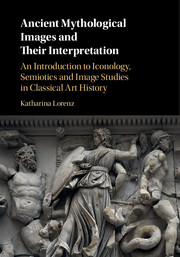 Ancient Mythological Images and their Interpretation
Ancient Mythological Images and their Interpretation from IMAGE STUDIES
Published online by Cambridge University Press: 05 August 2016
Image studies as experiment: the results
Image studies focuses on a picture's share in negotiating – and shaping – reality, that is, on its functional aspects and the logistics of its display. At the stage of spatial analysis, the case studies demonstrate the strength of image studies in its scrutiny of the compositional design of a picture by highlighting certain features from specific viewpoints, which creates varying perspectives on the picture as an artefact. In combining elements of the syntactic assessment of semiotics with iconology's iconography, this stage appropriates these elements in a new way. While semioticised syntactics is concerned with the internal structure of a picture, and iconological iconographics with the external connection between individual motifs within the picture and other such motifs in other pictures, image studies occupies a middle ground with its consideration of the internal structures of a picture as shaped by their perception.
At this stage, everything in and around the picture is under scrutiny: the elements that make the depiction as well as the empty spaces around them, both within the picture and within its immediate environment. That approach is firmly rooted in semioticised reception aesthetics, and in narratology more generally. Additionally, it emulates those interpretive mechanisms in a spatio-physical approach within which the focus is on the performativity of the picture and on what is on display at different points in the picture's use: the ‘what’ of the picture as presented through the ‘how’ of its physical display.
In the case of the Karlsruhe hydria, this approach reveals any blind spots created by the heterogeneous arrangement of the two pictorial areas and considers how these areas would have been perceived whilst the pot was lifted, tilted, or turned. It also highlights the visual connections established across the two pictorial zones. With regard to the Pergamon altar, it throws into relief the compositional arrangement of the Great Frieze along the stairs and reveals the display as the endpoint of the various compositional strategies that have been devised to anchor the depiction within the sphere of its audience and that serve to create a pervasive experience of the narrative as a whole. Similarly, for the Louvre sarcophagus, the focus on spatial design establishes a specific take on narrative sequence as played out on the casket.
To save this book to your Kindle, first ensure [email protected] is added to your Approved Personal Document E-mail List under your Personal Document Settings on the Manage Your Content and Devices page of your Amazon account. Then enter the ‘name’ part of your Kindle email address below. Find out more about saving to your Kindle.
Note you can select to save to either the @free.kindle.com or @kindle.com variations. ‘@free.kindle.com’ emails are free but can only be saved to your device when it is connected to wi-fi. ‘@kindle.com’ emails can be delivered even when you are not connected to wi-fi, but note that service fees apply.
Find out more about the Kindle Personal Document Service.
To save content items to your account, please confirm that you agree to abide by our usage policies. If this is the first time you use this feature, you will be asked to authorise Cambridge Core to connect with your account. Find out more about saving content to Dropbox.
To save content items to your account, please confirm that you agree to abide by our usage policies. If this is the first time you use this feature, you will be asked to authorise Cambridge Core to connect with your account. Find out more about saving content to Google Drive.